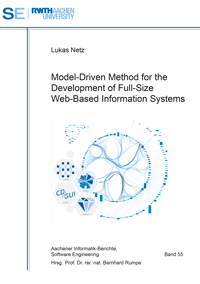
Shop : Details
Shop
Details
39,80 €ISBN 978-3-8440-9733-7Softcover422 pages774 g24 x 17 cmEnglishThesis
December 2024
Lukas Netz
Model-Driven Method for the Development of Full-Size Web-Based Information Systems
The implementation of information systems poses a variety of challenges for developers and requires a large number of experts from different application domains. This work presents a methodology in the area of generative model-driven development (MDD) for web-based information systems. The methodology consists of three basic building blocks: LLM4CD, CD2GUI, and MontiGem. The first building block LLM4CD is based on generative artificial intelligence (LLMs) and transforms natural language requirements and domain descriptions into class diagrams in CD4A notation. The second building block CD2GUI uses these class diagrams and derives models for user interfaces in GUIDSL notation. The last building block is MontiGem. It uses both types of models to generate a data-centric information system.
An important part of this work is the adaptability of the generated artifacts, this mainly concerns the possibility for modelers to adapt the models generated by the AI and CD2GUI, and to adapt and extend the code generated by MontiGem without having to edit the generated code or models directly.
This adaptability facilitates the transition from an underspecified modeled software prototype to a full-size model-driven information system that can be actively used in industry. In addition to the three building blocks, this thesis also presents the domain-specific modeling languages GUI-DSL and CD4A. The methodology is evaluated and discussed both in parts and as a whole. The practical applicability of the methodology is demonstrated using the case study MaCoCo, an information system used by RWTH Aachen University, which serves as a robust benchmark for the validation of the methodology.
An important part of this work is the adaptability of the generated artifacts, this mainly concerns the possibility for modelers to adapt the models generated by the AI and CD2GUI, and to adapt and extend the code generated by MontiGem without having to edit the generated code or models directly.
This adaptability facilitates the transition from an underspecified modeled software prototype to a full-size model-driven information system that can be actively used in industry. In addition to the three building blocks, this thesis also presents the domain-specific modeling languages GUI-DSL and CD4A. The methodology is evaluated and discussed both in parts and as a whole. The practical applicability of the methodology is demonstrated using the case study MaCoCo, an information system used by RWTH Aachen University, which serves as a robust benchmark for the validation of the methodology.
Keywords: Model-Driven Software Development; Generative AI; Domain Specific Languages; Prototyping
Aachener Informatik-Berichte, Software Engineering
Edited by Prof. Dr. rer. nat. Bernhard Rumpe, Aachen
Volume 55
Other formats
Electronic publication (PDF): 978-3-8440-9833-4
Export of bibliographic data
Shaker Verlag GmbH
Am Langen Graben 15a
52353 Düren
Germany
Am Langen Graben 15a
52353 Düren
Germany
Mon. - Thurs. 8:00 a.m. to 4:00 p.m.
Fri. 8:00 a.m. to 3:00 p.m.
Fri. 8:00 a.m. to 3:00 p.m.
Contact us. We will be happy to help you.



